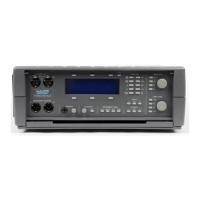It is most common to limit the bandwidth to 80 kHz, since this will reject
high-frequency noise while passing the second and third harmonics of signals up to
22 kHz, the top of the audible frequency range.
You may want to limit the lower band limit to remove hum from the measurement.
Using the 400 Hz highpass filter will eliminate the hum products while passing all
fundamentals, interference, distortion products, and noise above 400 Hz.
Following is an example of the use of various bandwidth-limiting filters. The
spectrum of the original signal may look like this:
After the bandpass filter eliminates the 1 kHz fundamental tone, we are left with the
following:
This signal contains contributions from harmonic distortion (at 2 kHz, 3 kHz, and 4
kHz), an interfering tone (at 490 Hz), random noise, and 60 Hz hum. The THD+N
measurement includes all of these, and reads 0.229 %.
If we use the 400 Hz bandpass filter to eliminate the hum, the spectrum of the signal
then looks like this:
The THD+N now measures 0.185 %. From this, we can determine that the hum
product was contributing 0.044 % to the THD+N reading.
-140
+20
-120
-100
-80
-60
-40
-20
+0
d
B
r
A
20 50 100 200 500 1k 2k 5k 10k 20k 50k
Hz
200k100k 300k
-140
+20
-120
-100
-80
-60
-40
-20
+0
20 50 100 200 500 1k 2k 5k 10k 20k 50k
d
B
r
A
200k100k 300k
20 50 100 200 500 1k 2k 5k 10k 20k 50k
Hz
-140
+20
-120
-100
-80
-60
-40
-20
+0
d
B
r
A
200k100k 300k
4 Operation
Operation Controlling the Analyzer : THD+N (Total Harmonic Distortion plus Noise)
4-32 Portable One Plus Access User's Manual
Artisan Technology Group - Quality Instrumentation ... Guaranteed | (888) 88-SOURCE | www.artisantg.com

